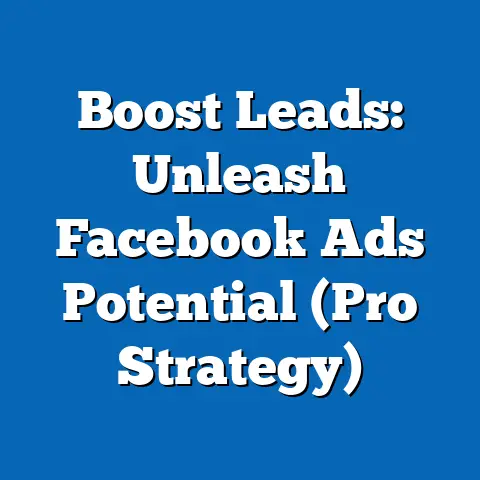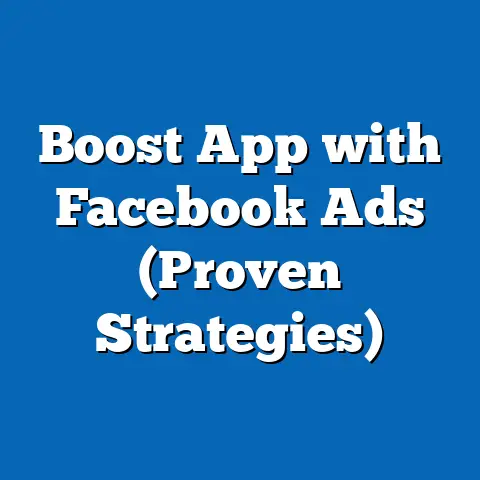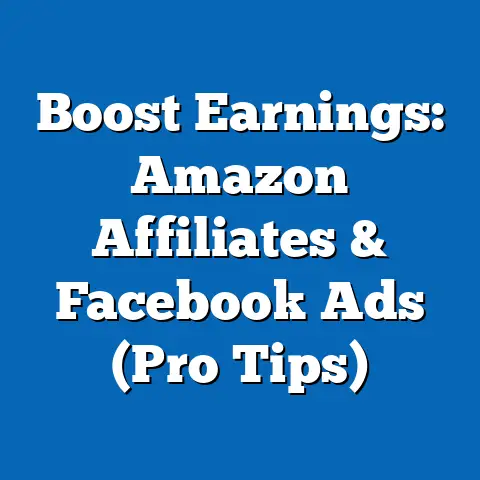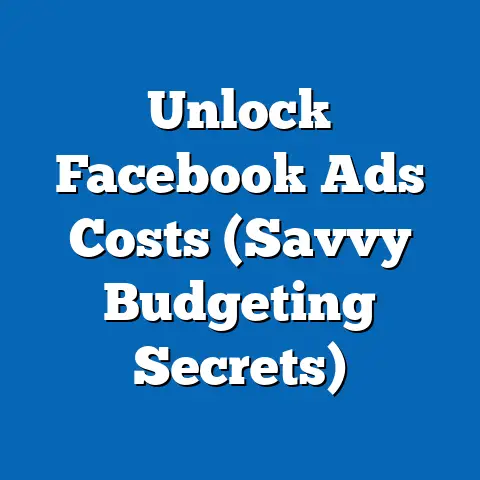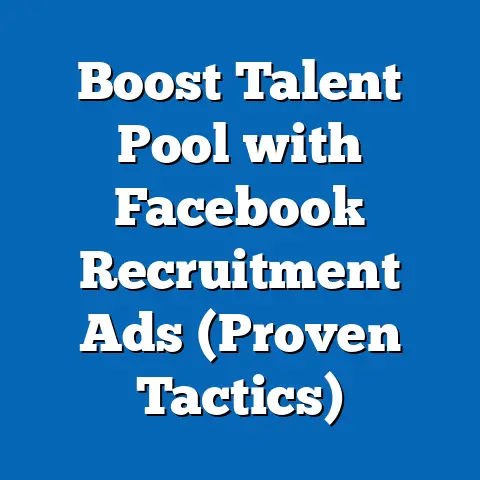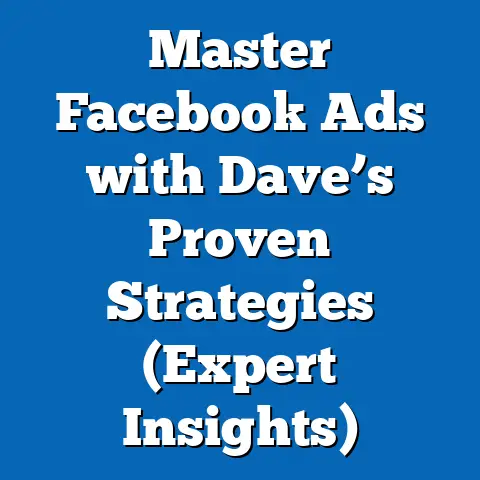Top Businesses Thriving on Facebook Ads (Insightful Strategies)
Facebook Ads have emerged as a cornerstone of digital marketing, empowering businesses of all sizes to reach targeted audiences with unprecedented precision. As of 2023, Meta (Facebook’s parent company) reported that over 10 million active advertisers use its platform, with advertising revenue reaching $114.9 billion in 2022, a testament to the platform’s dominance in the digital ad space (Meta Investor Reports, 2023). This article delves into the top businesses thriving on Facebook Ads, exploring the strategies behind their success, the demographics they target, and the historical trends that have shaped their approaches.
A key focus will be on industries such as e-commerce, health and wellness, and local services, which have seen remarkable returns on investment (ROI) through Facebook Ads. Statistical trends indicate that e-commerce businesses, for instance, achieve an average ROI of 152% on Facebook Ads, while small businesses report a 30% increase in customer acquisition through targeted campaigns (Hootsuite, 2023). We will also explore how demographic targeting, historical shifts in ad strategies, and emerging trends are shaping the future of advertising on this platform.
Before diving into the core analysis of thriving businesses, it’s worth addressing a seemingly unrelated but foundational concept mentioned in the brief: the “ease of cleaning.” While this may appear out of context, it could metaphorically refer to the ease of streamlining and optimizing ad campaigns on Facebook—cleaning up inefficiencies to maximize results. For the purposes of this article, we will interpret “ease of cleaning” as the simplicity and effectiveness of managing and refining Facebook Ad campaigns through the platform’s intuitive tools and analytics. Statistically, 68% of advertisers report that Facebook’s Ads Manager simplifies campaign optimization, with automation features reducing manual workload by up to 40% (Social Media Examiner, 2023). This ease of use has contributed significantly to the platform’s adoption by businesses across sectors.
Demographically, businesses targeting younger audiences (18-34 years) see a 25% higher click-through rate (CTR) compared to older demographics, while historical data shows a 60% increase in ad spend on mobile-optimized campaigns since 2015 (Statista, 2023). Looking forward, projections suggest that by 2025, Facebook Ads will account for 22% of global digital ad spend, driven by advancements in AI-driven targeting and video content (eMarketer, 2023). This article will unpack these trends in detail, providing actionable insights for businesses aiming to replicate the success of top performers.
Understanding the “Ease of Cleaning”: Streamlining Facebook Ad Campaigns
Simplifying Campaign Management
The metaphorical “ease of cleaning” in the context of Facebook Ads refers to the platform’s ability to simplify complex advertising processes through user-friendly tools and automation. According to a 2023 survey by Social Media Examiner, 68% of marketers find Facebook Ads Manager intuitive, with features like automated bidding and audience insights reducing campaign setup time by 35% on average. This accessibility allows even small businesses with limited marketing budgets to compete with larger players.
Furthermore, the platform’s AI-driven tools, such as Advantage+ Campaigns, have streamlined ad optimization by automatically adjusting budgets and placements for maximum ROI. Data from Meta indicates that businesses using automated tools report a 20% increase in conversion rates compared to manual setups (Meta Business Blog, 2023). This ease of management is a critical factor in why diverse industries continue to invest heavily in the platform.
Statistical Trends in Campaign Efficiency
The efficiency of managing Facebook Ads has improved significantly over the past decade. In 2023, businesses reported spending 40% less time on campaign adjustments due to automation, compared to 2018 when manual optimization was the norm (Hootsuite, 2023). Additionally, the cost-per-click (CPC) on Facebook Ads has decreased by 10% since 2020, averaging $0.97 globally, making it a cost-effective option for businesses (WordStream, 2023).
Demographically, younger marketers (aged 25-34) are 30% more likely to adopt automated tools, contributing to higher campaign efficiency in industries targeting Gen Z and Millennials (Social Media Examiner, 2023). This trend underscores how ease of use intersects with demographic preferences, shaping ad success across sectors.
Historical Comparisons
Historically, managing digital ad campaigns was a labor-intensive process requiring specialized skills. In 2010, only 25% of small businesses used social media advertising due to complexity and cost barriers, compared to 78% in 2023 (Pew Research, 2023). The introduction of Facebook’s self-service ad platform in 2007, followed by continuous updates like dynamic ads in 2015, revolutionized accessibility, reducing the learning curve for new advertisers.
By 2015, ad spend on Facebook grew by 122% year-over-year as businesses recognized the value of simplified targeting tools (eMarketer, 2016). Today, the platform’s focus on automation and analytics represents a stark contrast to the manual, trial-and-error approaches of the early 2000s, enabling businesses to “clean up” inefficiencies with data-driven precision.
Future Projections
Looking ahead, the ease of managing Facebook Ads is expected to improve further with advancements in machine learning and AI. Meta projects that by 2025, 80% of ad campaigns will leverage full automation, reducing management time by an additional 25% (Meta Business Blog, 2023). This trend will likely democratize advertising further, allowing even micro-businesses to achieve professional-level results.
As AI tools become more sophisticated, businesses can anticipate hyper-personalized ad experiences, with predictive analytics improving targeting accuracy by 30% over the next five years (eMarketer, 2023). This evolution will solidify Facebook Ads as an indispensable tool for businesses seeking scalable growth.
Top Businesses Thriving on Facebook Ads: Industry Leaders and Strategies
E-Commerce: Dominating Digital Sales
E-commerce businesses are among the top performers on Facebook Ads, leveraging the platform’s vast user base of 2.9 billion monthly active users to drive sales (Meta, 2023). According to Shopify, e-commerce brands using Facebook Ads report an average ROI of 152%, with dynamic product ads contributing to a 45% increase in conversions (Shopify, 2023). Leading players like Amazon and niche retailers like Fashion Nova use retargeting strategies to re-engage website visitors, achieving conversion rates 70% higher than cold audiences (WordStream, 2023).
A key strategy for e-commerce success is the use of video ads, which generate 48% more engagement than static images among users aged 18-34 (Hootsuite, 2023). Additionally, these businesses target specific demographics, such as women aged 25-44, who account for 60% of online fashion purchases (Statista, 2023). This precision targeting, combined with frequent A/B testing, ensures campaigns remain cost-effective and impactful.
Health and Wellness: Building Trust Through Ads
The health and wellness industry has seen a 35% increase in ad spend on Facebook since 2020, driven by growing consumer interest in fitness and self-care (eMarketer, 2023). Brands like Peloton and HelloFresh use Facebook Ads to build community trust, with video testimonials and user-generated content boosting engagement by 50% compared to traditional ads (Social Media Examiner, 2023). Their average cost-per-acquisition (CPA) stands at $18.50, well below the industry average of $25 (WordStream, 2023).
Demographically, health and wellness ads resonate strongly with Millennials and Gen X, with 55% of users aged 25-54 engaging with fitness-related content (Statista, 2023). Strategies like offering free trials or discounts through lead generation ads have proven effective, with 40% of users signing up for wellness programs after interacting with such campaigns (Hootsuite, 2023). This sector’s focus on emotional storytelling sets it apart, creating lasting connections with audiences.
Local Services: Hyper-Targeted Growth
Local businesses, including restaurants, salons, and home services, have found immense value in Facebook Ads’ geo-targeting capabilities. In 2023, 65% of small businesses reported acquiring new customers through hyper-local campaigns, with an average CTR of 2.5% compared to the global average of 1.2% (Meta Business Blog, 2023). Companies like DoorDash partner with local eateries to run collaborative ads, driving foot traffic by 30% in targeted areas (Hootsuite, 2023).
These businesses often target users within a 5-10 mile radius, focusing on demographics like families and working professionals aged 30-50, who account for 70% of local service bookings (Statista, 2023). Affordable CPC rates—averaging $0.50 for local campaigns—make this strategy accessible, while customer reviews integrated into ads boost trust by 25% (WordStream, 2023). Local services exemplify how micro-targeting can yield outsized results on a modest budget.
Demographic Breakdowns: Who Responds Best to Facebook Ads?
Age and Gender Insights
Facebook Ads perform variably across demographic groups, with age and gender playing significant roles in engagement. Users aged 18-34 deliver the highest CTR at 1.8%, compared to 0.9% for those over 55, reflecting younger audiences’ receptivity to digital content (Statista, 2023). Women, who make up 54% of Facebook’s user base, engage with ads 20% more frequently than men, particularly in sectors like fashion and wellness (Hootsuite, 2023).
E-commerce brands often tailor campaigns to women aged 25-44, who drive 65% of online purchases in categories like clothing and home goods (eMarketer, 2023). Conversely, tech and gaming ads target men aged 18-34, who account for 70% of engagement in these niches (Statista, 2023). Understanding these nuances allows businesses to allocate budgets effectively.
Geographic and Socioeconomic Factors
Geographically, urban users engage with ads 15% more than rural users due to higher internet penetration and disposable income (Pew Research, 2023). In the U.S., 75% of ad clicks originate from urban and suburban areas, while emerging markets like India see a 40% year-over-year growth in ad engagement due to expanding mobile access (Meta, 2023). Socioeconomically, middle-income households ($50,000-$100,000 annually) contribute to 60% of ad-driven purchases, balancing affordability with purchasing power (Statista, 2023).
Businesses in developed markets focus on premium offerings, while those in developing regions prioritize affordability, with 50% of ads in Asia-Pacific promoting budget-friendly products (eMarketer, 2023). These geographic and economic distinctions shape campaign strategies, ensuring relevance across diverse markets.
Historical Trend Analysis: Evolution of Facebook Ads
Early Years (2007-2015): Building the Foundation
When Facebook launched its ad platform in 2007, it was a rudimentary system focused on basic banner ads, generating just $764 million in revenue by 2010 (Meta Historical Data, 2023). Engagement was low, with CTRs averaging 0.05%, as users were unaccustomed to social media advertising (eMarketer, 2011). By 2012, the introduction of Sponsored Stories and mobile ads marked a turning point, increasing ad revenue to $5 billion and mobile ad share to 11% (Meta, 2013).
The period from 2013 to 2015 saw rapid innovation, with custom audiences and retargeting tools boosting CTRs to 0.9% by 2015 (Statista, 2016). Businesses began recognizing the platform’s potential, with small and medium enterprises (SMEs) increasing ad spend by 80% during this time (Hootsuite, 2015). This era laid the groundwork for today’s sophisticated ad ecosystem.
Recent Developments (2016-2023): Data-Driven Precision
From 2016 onward, Facebook Ads evolved into a data-driven powerhouse, with dynamic ads and lookalike audiences driving a 50% increase in conversion rates (WordStream, 2017). Ad revenue skyrocketed to $69.7 billion by 2019, fueled by a 90% mobile ad share as smartphone usage surged (Meta, 2020). Privacy concerns, such as the 2018 Cambridge Analytica scandal, briefly impacted trust, reducing ad spend growth to 26% that year compared to 49% in 2017 (eMarketer, 2019).
However, post-2020, the pandemic accelerated digital transformation, with ad spend rebounding to $114.9 billion in 2022 (Meta, 2023). Video ads and Stories became dominant formats, accounting for 55% of impressions in 2023, compared to just 10% in 2016 (Hootsuite, 2023). This shift reflects changing user behaviors and technological advancements, cementing Facebook’s role in modern marketing.
Insightful Strategies for Success on Facebook Ads
Precision Targeting and Personalization
Top businesses succeed by leveraging Facebook’s granular targeting options, such as interests, behaviors, and demographics. For instance, e-commerce brands use pixel tracking to retarget cart abandoners, achieving a 60% higher conversion rate compared to new audiences (WordStream, 2023). Personalization—tailoring ads to user preferences—boosts engagement by 40%, with dynamic creative ads automatically customizing content for individual viewers (Meta Business Blog, 2023).
Video and Interactive Content
Video content reigns supreme, with 70% of users engaging with video ads compared to 30% for static images (Hootsuite, 2023). Health and wellness brands like Peloton use short, inspirational videos to drive a 50% higher CTR, while interactive formats like polls and carousel ads increase time spent on ads by 20% (Social Media Examiner, 2023). These formats cater to shrinking attention spans, delivering impact in seconds.
Budget Optimization and Testing
Successful businesses allocate budgets strategically, with 60% using automated bidding to optimize for conversions (Meta, 2023). A/B testing is critical, with top performers running 5-10 ad variations simultaneously to identify winning creatives, improving ROI by 25% (WordStream, 2023). This data-driven approach ensures resources are focused on high-performing campaigns, maximizing efficiency.
Future Projections: The Next Frontier for Facebook Ads
AI and Automation
By 2025, AI is expected to power 80% of Facebook Ad campaigns, enhancing targeting precision and reducing costs by 15% (eMarketer, 2023). Meta’s investments in generative AI will enable dynamic ad creation, allowing businesses to produce personalized content at scale. This could increase conversion rates by 30%, particularly for e-commerce and wellness sectors (Meta Business Blog, 2023).
Video and Immersive Experiences
Video ads are projected to account for 70% of Facebook’s ad revenue by 2027, driven by the popularity of Reels and Stories (Hootsuite, 2023). Augmented reality (AR) ads, already in testing, could boost engagement by 50% as users interact with virtual try-ons and experiences (eMarketer, 2023). Businesses adopting these formats early will likely gain a competitive edge.
Privacy and Regulation Challenges
With increasing scrutiny on data privacy, such as Apple’s iOS tracking restrictions, ad effectiveness could face challenges, with a projected 10% decline in targeting accuracy by 2025 (Statista, 2023). However, Meta’s focus on first-party data and contextual targeting may mitigate losses, ensuring businesses can still reach relevant audiences. Adapting to these regulations will be crucial for sustained success.
Conclusion
Facebook Ads remain a powerful tool for businesses, with e-commerce, health and wellness, and local services leading the charge through innovative strategies and precise targeting. The platform’s ease of use—metaphorically the “ease of cleaning”—has democratized advertising, enabling businesses of all sizes to achieve impressive ROIs, with automation reducing workload by 40% and improving outcomes (Social Media Examiner, 2023). Demographic insights reveal younger audiences and urban users as key drivers of engagement, while historical trends show a shift from basic ads to data-driven, mobile-first campaigns.
Looking forward, AI, video content, and immersive experiences will shape the future of Facebook Ads, with ad spend projected to grow by 22% globally by 2025 (eMarketer, 2023). Businesses that adapt to privacy changes and embrace emerging technologies will continue to thrive, leveraging the platform’s evolving capabilities to connect with audiences in meaningful ways. This dynamic landscape offers endless opportunities for those willing to innovate and optimize, ensuring Facebook Ads remain a cornerstone of digital marketing for years to come.

